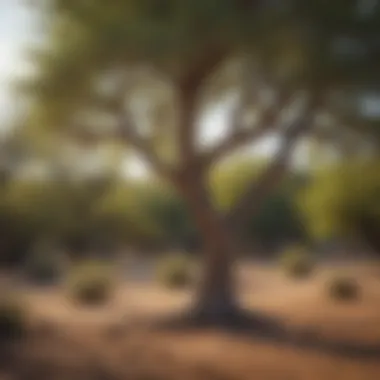Discover the Best Trees to Plant in Central Texas for a Vibrant Landscape


Tree Species Profile
- Overview of tree importance
- Characteristics and suitability
- Best cultivation practices and tips
- Landscaping benefits
Central Texas presents a unique ecosystem that supports a variety of tree species, each contributing distinct benefits to the local environment. Understanding the significance of planting the right trees in this region is crucial for enhancing the landscape's natural beauty and ecosystem functionality. By delving into the characteristics and suitability of different tree species, individuals can make informed decisions on selecting trees that not only thrive in Central Texas but also complement their outdoor space. This section will explore the best cultivation practices and tips for ensuring the successful growth of these trees, highlighting the landscaping benefits they offer and how they can transform outdoor spaces into vibrant, sustainable habitats.
Introduction
When delving into the realm of landscaping in Central Texas, the choice of trees plays a pivotal role in shaping not just the aesthetic appeal but also the overall resilience of the outdoor environment. Central Texas, known for its unique climatic conditions and varying soil types, presents a distinctive set of challenges and opportunities for tree cultivation. Understanding the nuances of selecting the right trees for this region is crucial for creating sustainable green spaces that thrive and flourish.
In this article, we embark on a journey through the realm of Central Texas trees, exploring a rich tapestry of species that have proven their mettle in the harsh yet rewarding environment of this region. By dissecting the climate adaptability, soil requirements, and watering needs essential for successful tree growth in Central Texas, we aim to equip readers with the knowledge needed to make informed choices for their landscaping endeavors.
Through an in-depth exploration of each top tree species – from the iconic Live Oak and the resilient Cedar Elm to the vibrant Texan Red Oak and the majestic Pecan – we unravel the unique characteristics and benefits that set these trees apart. By delving into the attributes of the Mexican Plum, the Texas Mountain Laurel, the Anacua, and a host of other revered species, we offer a nuanced understanding of the diverse botanical tapestry that adorns Central Texas landscapes.
As we navigate through planting and care tips tailored specifically for the requirements of Central Texas, we shed light on best practices that ensure the longevity and vitality of these trees. By synthesizing the wealth of information presented in this article, readers will emerge with a comprehensive guide to selecting and nurturing the best trees for their personal arboreal haven in the heart of Texas.
Factors to Consider
Climate Adaptability
Climate adaptability stands as a crucial criterion in choosing trees for Central Texas due to the region's diverse weather patterns and conditions. The area experiences hot summers, occasional droughts, and mild winters, making it vital to select tree species that can withstand these fluctuations. Trees like Live Oak and Texas Red Oak demonstrate excellent adaptability to the Central Texas climate, thriving in both extreme heat and occasional cold snaps. Ensuring that your chosen tree species can acclimate to the region's specific climate is key to their long-term health and growth.


Soil Requirements
Understanding the soil requirements of different tree species is essential for their successful establishment and development in Central Texas. The region's soil composition varies, with some areas having sandy soil, while others have clay-rich soil. Trees such as Pecan and Texas Mountain Laurel have specific soil preferences, with Pecan trees thriving in deep, well-drained soils and Texas Mountain Laurel preferring slightly acidic soils. Prior to planting a tree, conducting soil tests and amending the soil accordingly can create optimal conditions for healthy root growth and overall tree vitality.
Watering Needs
Watering plays a significant role in the growth and sustainability of trees in Central Texas, where periods of drought are not uncommon. Different tree species have varying watering requirements, with some needing regular irrigation during dry spells, while others are more drought-tolerant. Trees such as Mexican Plum and Anacua are known for their adaptability to drier conditions, requiring minimal watering once established. Understanding the specific watering needs of the trees you choose to plant is essential in ensuring their resilience to Central Texas' sometimes arid climate.
Top Tree Species
In the realm of landscaping, the selection of the best trees holds paramount significance. Each tree species carries unique traits, benefits, and considerations that can greatly impact the overall aesthetic and environmental quality of outdoor spaces. The following discussion delves deep into the top tree species perfectly suited for the climatic and soil conditions of Central Texas.
Live Oak
Live Oak, esteemed for its majestic presence and robust nature, stands out as a quintessential choice for Central Texas landscaping. With its broad canopy providing ample shade and its resilience to withstand the region's varying weather patterns, Live Oak exemplifies durability and charm. Careful consideration of Live Oak's growth habits and shade requirements is crucial in maximizing its ornamental value within a landscape.
Cedar Elm
Cedar Elm emerges as a resilient and adaptable tree species, well-equipped to thrive in Central Texas's challenging environment. Its distinctive serrated leaves and elegant shape add visual interest to outdoor spaces. As an eco-friendly choice, Cedar Elm offers not only shade and aesthetic value but also significant benefits for local wildlife.
Texas Red Oak
The Texas Red Oak commands attention with its vibrant autumn foliage, making it a standout choice for seasonal appeal in Central Texas landscapes. Known for its adaptability to various soil conditions and its moderate growth rate, the Texas Red Oak presents a compelling option for property owners seeking both visual impact and ease of maintenance.


Pecan
Pecan trees symbolize tradition and prosperity, providing not only visual beauty but also a bountiful harvest of nutritious nuts. In a Central Texas setting, Pecans thrive, offering shade during hot summers and a splash of yellow hues during the fall. Careful consideration of their mature size is crucial to avoid overcrowding in a landscape.
Mexican Plum
Mexican Plum exudes elegance with its fragrant spring blossoms and delectable summer fruit. Ideal for adding a touch of diversity to Central Texas landscapes, Mexican Plum trees attract pollinators and wildlife, enhancing the ecological balance of the area while simultaneously delighting the senses of onlookers.
Texas Mountain Laurel
Texas Mountain Laurel, with its vibrant blooms and aromatic scent, elevates the sensory experience of any outdoor setting. Its drought tolerance and evergreen nature make it a valuable asset to Central Texas landscapes seeking year-round visual appeal. Judicious pruning and proper drainage are essential for unlocking the full ornamental potential of this captivating species.
Anacua
Anacua, with its glossy foliage and profusion of white flowers, exudes understated elegance in the Central Texas landscape. Its adaptability to the region's soil and weather conditions makes it a low-maintenance yet visually striking choice for both residential and commercial properties. Pruning to enhance its natural shape and regular watering considerations are essential practices for ensuring Anacua's long-term vitality.
Chinkapin Oak
Chinkapin Oak stands tall as a symbol of strength and resilience in Central Texas environments. With its distinctive bark patterns and rich green foliage, this oak species offers both visual interest and shade benefits to outdoor spaces. Mindful consideration of its deep root system and spacing requirements is crucial to harness its full potential within a landscape.
Monterrey Oak
Monterrey Oak, with its graceful form and adaptability to various soil types, holds immense allure for Central Texas landscaping projects. Its rapid growth rate and pest resistance make it a practical choice for property owners seeking swift results without compromising on aesthetics. Pruning for structure and occasional deep watering are essential elements in ensuring the longevity and health of Monterrey Oak within the landscape.


Escarpment Black Cherry
Escarpment Black Cherry presents a unique botanical marvel for Central Texas landscapes, boasting ornamental qualities that set it apart from other tree species. With its delicate white blossoms and edible cherries, this tree serves as a multifaceted addition, offering visual appeal, ecological benefits, and a touch of culinary interest. Proper soil drainage and periodic fertilization are key considerations for supporting the growth and vibrancy of Escarpment Black Cherry within the landscape.
Planting and Care Tips
When considering the planting and care tips for trees in the Central Texas region, it is essential to understand the crucial role that proper planting and maintenance play in the long-term health and vitality of the trees. Central Texas presents a unique set of challenges and opportunities for tree growth, making it imperative to follow best practices in planting and care. By adhering to these guidelines, tree enthusiasts can ensure the successful establishment and growth of their chosen tree species.
Importance of Proper Planting
Proper planting techniques are foundational to the health and resilience of trees in Central Texas. When planting trees, it is vital to consider factors such as soil quality, drainage, sunlight exposure, and spacing. The correct depth and width of the planting hole, adequate mulching, and strategic placement are all essential elements to promote optimal root development and overall tree health. By planting trees correctly, individuals can establish a strong foundation for growth and minimize the risk of stress or disease.
Care and Maintenance Strategies
Beyond planting, ongoing care and maintenance are critical for the sustained well-being of trees in Central Texas. Regular watering, especially during the hot and dry seasons, is paramount to support tree hydration and growth. Mulching around the base of the tree helps retain moisture, regulate soil temperature, and suppress weed growth. Additionally, pruning damaged or diseased branches, monitoring for pest infestations, and fertilizing as needed are integral components of tree care. By adopting a proactive approach to maintenance, tree owners can ensure the longevity and vitality of their trees.
Environmental Considerations
In the context of Central Texas' climate and soil conditions, it is essential to consider environmental factors when planting and caring for trees. The arid climate and periodic droughts necessitate water conservation practices and drought-resistant tree species selection. Understanding the local climate patterns, seasonal variations, and soil composition is crucial in developing a tailored care routine for optimal tree health. By aligning planting and care practices with the unique environmental characteristics of Central Texas, tree enthusiasts can create a sustainable and thriving landscape.
Conclusion
Conclusion
In this article, we have delved into the diverse array of tree species that thrive in the unique climate and soil conditions of Central Texas. From the majestic Live Oak to the delicate Mexican Plum, each tree offers distinct characteristics and benefits that cater to different landscaping needs and preferences. By highlighting the specific traits and advantages of each tree species, readers have gained valuable insights into making informed decisions when selecting trees for their outdoor spaces.
Moreover, the significance of choosing trees that are well-adapted to the local climate cannot be overstated. Trees that are suitable for the Central Texas region not only thrive in the hot and dry conditions prevalent in the area but also contribute to water conservation efforts and environmental sustainability. By planting trees that are resilient to the region's climatic challenges, individuals can create thriving green spaces that enhance the beauty and functionality of their landscapes.
Furthermore, the thoughtful selection of trees can have a positive impact on the overall ecosystem health and biodiversity of Central Texas. Trees act as anchors for the soil, preventing erosion and maintaining soil health, while also providing shelter and sustenance for various wildlife species. The presence of diverse tree species ensures a rich ecosystem that supports the interconnected web of life, fostering a harmonious balance between flora and fauna in the region.







